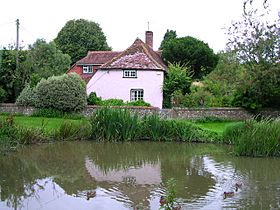River Lavant, West Sussex facts for kids
Quick facts for kids River Lavant |
|
|---|---|

The source of the Lavant at East Dean pond
|
|
| Country | England |
| Region | West Sussex |
| Physical characteristics | |
| Main source | East Dean, West Sussex West Sussex |
| River mouth | Chichester Harbour West Sussex |
| Length | 14.5 km (9.0 mi) |
The River Lavant is a special kind of river called a winterbourne. This means it often dries up in the summer and flows mainly in winter or after heavy rain. It starts near East Dean and travels west towards Singleton. Then, it turns south, flowing past villages like West Dean and Lavant, until it reaches the city of Chichester.
Long ago, the river naturally flowed south from Chichester to the sea at Pagham. But the Romans changed its path. They made it flow around the southern walls of Chichester and then west into Chichester Harbour. This change helped protect the city and manage its water.
Contents
Flooding and River Management
The Great Flood of 1994
In January 1994, there was a lot of rain. This caused the River Lavant to overflow its banks. Many homes and areas in Chichester and nearby villages were flooded. Important roads like the A27 and A259 had to close.
Big, old fire engines, nicknamed "Green Goddesses," were brought into the city. They stayed for several weeks. Their job was to pump out the water that had soaked into the ground. They used many miles of pipes to do this.
Building a Flood Relief Channel
In the autumn of 2000, there was another period of very heavy rain. People worried that Chichester would flood again. The Environment Agency quickly started an emergency project. They used special powers to build a new channel.
This new channel was designed to send extra water back into the river's old natural path, called Pagham Rife. The work was planned for 2001, but the emergency made them finish it in just two weeks. It was completed just days before the river was expected to surge.
This emergency work later became a permanent flood relief channel. It has special gates called sluices near Westhampnett. These sluices help control the water flow and prevent future floods.
Images for kids




